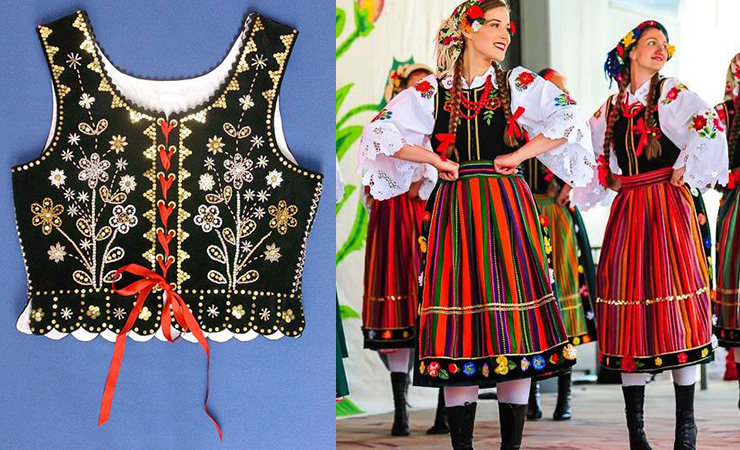
Polish traditional clothing reflects centuries of regional craftsmanship and cultural identity. Each piece is rich in symbolism, and the designs vary widely across different parts of Poland. Today, these garments are primarily worn during festivals, celebrations, and historical reenactments, serving as a link to the country’s deep-rooted traditions.
Traditional Polish Women’s Clothing
Gorset (Corset)
Gorset is one of the most iconic pieces of Polish women’s traditional attire. Made from fine fabrics such as velvet, the corset is often heavily embroidered with floral or geometric motifs that vary by region. It is worn over a blouse and tightly fitted to emphasize the waist, creating a feminine silhouette. The gorset is typically adorned with bright, bold colors, giving the outfit an elegant yet striking appearance.
Spódnica (Skirt)
Spódnica is a traditional Polish skirts are long, flowing, and made from wool or linen. These skirts are often decorated with intricate stripes, checkered patterns, or floral motifs. Some regional variations feature multicolored stripes or bright, single-color designs, while others are more subdued with subtle, earthy tones. The spódnica is usually layered with an apron for additional decoration and protection during work or celebration.
Zapaska (Apron)
Zapaska is worn over the skirt and serves both a practical and decorative role. Made from lighter materials such as cotton or lace, it is often richly embroidered with floral patterns and lace trimmings. In some regions, the apron is as colorful and detailed as the rest of the outfit, making it an essential piece for special occasions. The apron also reflects a woman’s skills in needlework, as many were handcrafted.
Chusta (Shawl)
Chusta is a large, fringed shawl is an indispensable part of traditional Polish women’s clothing. Made from wool or silk, the chusta is worn draped over the shoulders or tied around the neck to keep warm. It is often decorated with elaborate floral embroidery and is particularly prominent in the highland regions. The shawl not only provides warmth but also adds a layer of elegance to the outfit.
Wianek (Flower Crown)
Wianek is a delicate flower crown, or wianek, is traditionally worn by unmarried women during festivals and religious events. The crown is made of fresh or artificial flowers, woven into a circular shape and placed on the head. The flowers used often have symbolic meanings, such as purity and youth, and the crowns vary from region to region. In modern times, the wianek is still popular in wedding ceremonies as a symbol of innocence.
Traditional Polish Men’s Clothing
Żupan
Żupan is a long, fitted coat worn by men, particularly in the 16th and 17th centuries, and it remains a key part of traditional men’s attire in Poland. Made from luxurious materials such as wool, silk, or velvet, the żupan is typically adorned with buttons and fine embroidery. It is worn under the kontusz, another formal overcoat, and was historically a symbol of status. The style of the żupan could vary depending on the region, but it was always a garment worn for special occasions.
Kontusz
Kontusz is a loose overcoat that was historically associated with Polish nobility, known as the szlachta. Made from high-quality wool or silk, the kontusz has wide sleeves and is worn over the żupan. It is often tied at the waist with a wide, decorative belt called the pas kontuszowy. The kontusz reflects the wearer’s social standing and is usually reserved for formal events, such as weddings or national holidays.
Pas kontuszowy (Kontusz Belt)
Pas kontuszowy is an elaborately decorated belt that is worn around the kontusz. Made from silk or cotton, it features woven or embroidered designs that vary in color and pattern. The belt is usually wide and tied in a knot at the front, giving the outfit a formal and stately appearance. Historically, the belt symbolized wealth and power, and the quality of the material used was a mark of the wearer’s social class.
Portki (Trousers)
Portki are the traditional men’s trousers, known as portki, are typically made from wool or linen. They are loose-fitting and often tucked into boots for a practical and clean look. Some regions feature embroidered designs along the sides of the trousers, adding a decorative touch. The portki are an essential part of traditional Polish men’s clothing, particularly in rural areas where they were worn during both work and celebrations.
Modern Polish Clothing
In contemporary Poland, traditional clothing is mostly worn for cultural events, while modern fashion reflects global trends. Today, Polish fashion blends classic European styles with a minimalist, practical approach that emphasizes comfort and quality.
The post Complete Guide to Polish Clothing appeared first on The Fashiongton Post.
